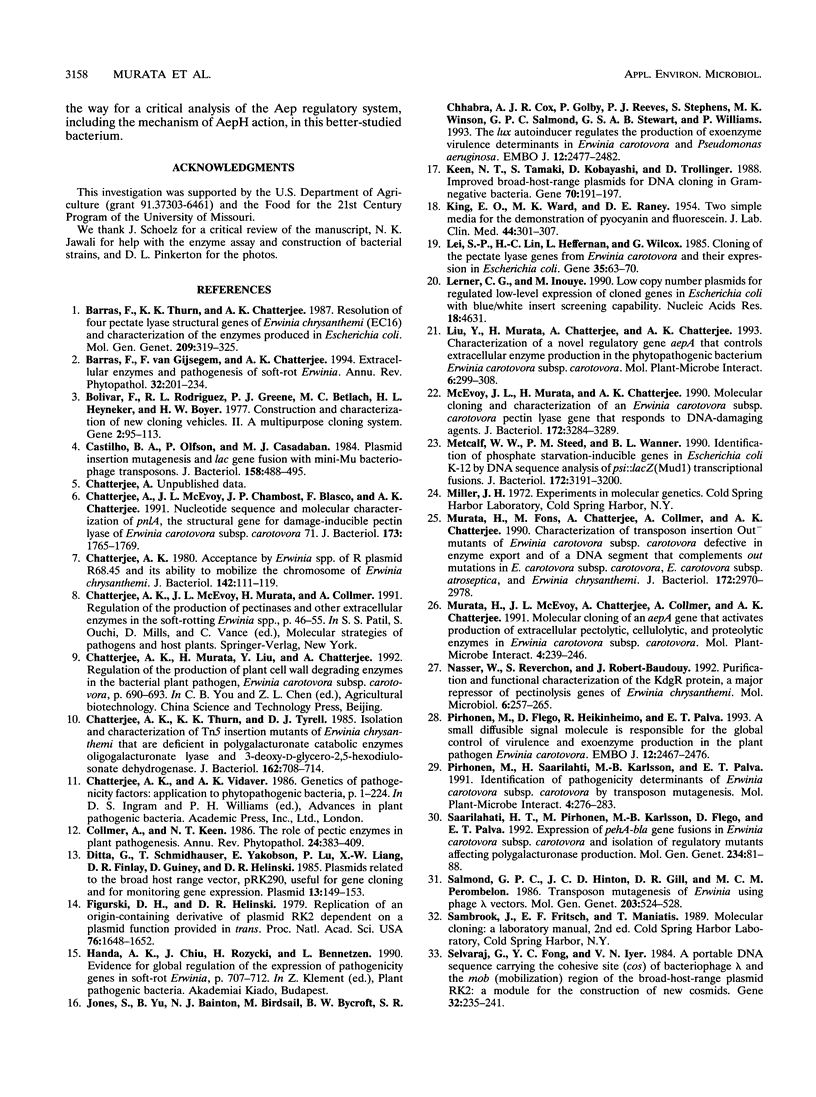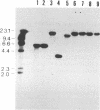Abstract
The production of pectolytic enzymes (pectate lyase [Pel] and polygalacturonase [Peh]), cellulase (Cel), and protease (Prt) is activated in the soft rot bacterium Erwinia carotovora subsp. carotovora by aepA (activator of extracellular protein production) and celery extract (Y. Liu, H. Murata, A. Chatterjee, and A. K. Chatterjee, Mol. Plant-Microbe Interact. 6:299-308, 1993). We recently isolated a new class of mutants of strain E. carotovora subsp. carotovora 71 which overproduces Pel, Peh, Cel, and Prt. From the overproducing strain AC5034, we identified an activator locus, designated aepH*, which stimulated Pel, Peh, Cel, and Prt production in E. carotovora subsp. carotovora 71 or its derivatives. The nucleotide sequence of the aepH* DNA segment revealed an open reading frame of 141 bp that could encode a small (5.45-kDa) highly basic (pI 11.7) protein of 47 amino acid residues. Analyses of deletions and MudI insertions indicated that the activator function required the 508-bp DNA segment which contains this open reading frame. The wild-type locus, aepH+, is localized within a DNA segment upstream of aepA. An AepH- strain constructed by exchanging aepH+ with aepH*::MudI was deficient in Pel, Peh, Cel, and Prt production; exoenzyme production was restored upon the introduction of a plasmid carrying aepH+ or aepH*. Plasmids carrying either aepH+ or aepH* activated the production of Pel-1, Peh-1, and Cel in Escherichia coli HB101 carrying the cognate genes. The aepH effect in E. coli was due to the activation of transcription, as indicated by assays of pel-1 and peh-1 mRNAs. The aepH+ and aepH* plasmids also stimulated Pel, Peh, Cel, and Prt production in other wild-type E. carotovora subsp. carotovora strains as well as in E. carotovora subsp. atroseptica. Although the stimulatory effect was generally more pronounced with aepH* than with aepH+, the extent of activation in the wild-type strains depended upon the bacterial strain and the growth medium. Southern blot hybridization revealed the presence of aepH homologs in E. carotovora subsp. carotovora and E. carotovora subsp. atroseptica, and provided physical evidence for linkage between aepA and aepH homologs in genomes of these bacteria. We conclude that aepH-mediated activation of exoprotein gene expression is a feature common to most strains of E. carotovora.
Full text
PDF









Images in this article
Selected References
These references are in PubMed. This may not be the complete list of references from this article.
- Barras F., Thurn K. K., Chatterjee A. K. Resolution of four pectate lyase structural genes of Erwinia chrysanthemi (EC16) and characterization of the enzymes produced in Escherichia coli. Mol Gen Genet. 1987 Sep;209(2):319–325. doi: 10.1007/BF00329660. [DOI] [PubMed] [Google Scholar]
- Bolivar F., Rodriguez R. L., Greene P. J., Betlach M. C., Heyneker H. L., Boyer H. W., Crosa J. H., Falkow S. Construction and characterization of new cloning vehicles. II. A multipurpose cloning system. Gene. 1977;2(2):95–113. [PubMed] [Google Scholar]
- Castilho B. A., Olfson P., Casadaban M. J. Plasmid insertion mutagenesis and lac gene fusion with mini-mu bacteriophage transposons. J Bacteriol. 1984 May;158(2):488–495. doi: 10.1128/jb.158.2.488-495.1984. [DOI] [PMC free article] [PubMed] [Google Scholar]
- Chatterjee A. K. Acceptance by Erwinia spp. of R plasmid R68.45 and its ability to mobilize the chromosome of Erwinia chrysanthemi. J Bacteriol. 1980 Apr;142(1):111–119. doi: 10.1128/jb.142.1.111-119.1980. [DOI] [PMC free article] [PubMed] [Google Scholar]
- Chatterjee A. K., Thurn K. K., Tyrell D. J. Isolation and characterization of Tn5 insertion mutants of Erwinia chrysanthemi that are deficient in polygalacturonate catabolic enzymes oligogalacturonate lyase and 3-deoxy-D-glycero-2,5-hexodiulosonate dehydrogenase. J Bacteriol. 1985 May;162(2):708–714. doi: 10.1128/jb.162.2.708-714.1985. [DOI] [PMC free article] [PubMed] [Google Scholar]
- Chatterjee A., McEvoy J. L., Chambost J. P., Blasco F., Chatterjee A. K. Nucleotide sequence and molecular characterization of pnlA, the structural gene for damage-inducible pectin lyase of Erwinia carotovora subsp. carotovora 71. J Bacteriol. 1991 Mar;173(5):1765–1769. doi: 10.1128/jb.173.5.1765-1769.1991. [DOI] [PMC free article] [PubMed] [Google Scholar]
- Ditta G., Schmidhauser T., Yakobson E., Lu P., Liang X. W., Finlay D. R., Guiney D., Helinski D. R. Plasmids related to the broad host range vector, pRK290, useful for gene cloning and for monitoring gene expression. Plasmid. 1985 Mar;13(2):149–153. doi: 10.1016/0147-619x(85)90068-x. [DOI] [PubMed] [Google Scholar]
- Figurski D. H., Helinski D. R. Replication of an origin-containing derivative of plasmid RK2 dependent on a plasmid function provided in trans. Proc Natl Acad Sci U S A. 1979 Apr;76(4):1648–1652. doi: 10.1073/pnas.76.4.1648. [DOI] [PMC free article] [PubMed] [Google Scholar]
- Jones S., Yu B., Bainton N. J., Birdsall M., Bycroft B. W., Chhabra S. R., Cox A. J., Golby P., Reeves P. J., Stephens S. The lux autoinducer regulates the production of exoenzyme virulence determinants in Erwinia carotovora and Pseudomonas aeruginosa. EMBO J. 1993 Jun;12(6):2477–2482. doi: 10.1002/j.1460-2075.1993.tb05902.x. [DOI] [PMC free article] [PubMed] [Google Scholar]
- KING E. O., WARD M. K., RANEY D. E. Two simple media for the demonstration of pyocyanin and fluorescin. J Lab Clin Med. 1954 Aug;44(2):301–307. [PubMed] [Google Scholar]
- Keen N. T., Tamaki S., Kobayashi D., Trollinger D. Improved broad-host-range plasmids for DNA cloning in gram-negative bacteria. Gene. 1988 Oct 15;70(1):191–197. doi: 10.1016/0378-1119(88)90117-5. [DOI] [PubMed] [Google Scholar]
- Lei S. P., Lin H. C., Heffernan L., Wilcox G. Cloning of the pectate lyase genes from Erwinia carotovora and their expression in Escherichia coli. Gene. 1985;35(1-2):63–70. doi: 10.1016/0378-1119(85)90158-1. [DOI] [PubMed] [Google Scholar]
- Lerner C. G., Inouye M. Low copy number plasmids for regulated low-level expression of cloned genes in Escherichia coli with blue/white insert screening capability. Nucleic Acids Res. 1990 Aug 11;18(15):4631–4631. doi: 10.1093/nar/18.15.4631. [DOI] [PMC free article] [PubMed] [Google Scholar]
- Liu Y., Murata H., Chatterjee A., Chatterjee A. K. Characterization of a novel regulatory gene aepA that controls extracellular enzyme production in the phytopathogenic bacterium Erwinia carotovora subsp. carotovora. Mol Plant Microbe Interact. 1993 May-Jun;6(3):299–308. doi: 10.1094/mpmi-6-299. [DOI] [PubMed] [Google Scholar]
- McEvoy J. L., Murata H., Chatterjee A. K. Molecular cloning and characterization of an Erwinia carotovora subsp. carotovora pectin lyase gene that responds to DNA-damaging agents. J Bacteriol. 1990 Jun;172(6):3284–3289. doi: 10.1128/jb.172.6.3284-3289.1990. [DOI] [PMC free article] [PubMed] [Google Scholar]
- Metcalf W. W., Steed P. M., Wanner B. L. Identification of phosphate starvation-inducible genes in Escherichia coli K-12 by DNA sequence analysis of psi::lacZ(Mu d1) transcriptional fusions. J Bacteriol. 1990 Jun;172(6):3191–3200. doi: 10.1128/jb.172.6.3191-3200.1990. [DOI] [PMC free article] [PubMed] [Google Scholar]
- Murata H., Fons M., Chatterjee A., Collmer A., Chatterjee A. K. Characterization of transposon insertion out- mutants of Erwinia carotovora subsp. carotovora defective in enzyme export and of a DNA segment that complements out mutations in E. carotovora subsp. carotovora, E. carotovora subsp. atroseptica, and Erwinia chrysanthemi. J Bacteriol. 1990 Jun;172(6):2970–2978. doi: 10.1128/jb.172.6.2970-2978.1990. [DOI] [PMC free article] [PubMed] [Google Scholar]
- Nasser W., Reverchon S., Robert-Baudouy J. Purification and functional characterization of the KdgR protein, a major repressor of pectinolysis genes of Erwinia chrysanthemi. Mol Microbiol. 1992 Jan;6(2):257–265. doi: 10.1111/j.1365-2958.1992.tb02007.x. [DOI] [PubMed] [Google Scholar]
- Pirhonen M., Flego D., Heikinheimo R., Palva E. T. A small diffusible signal molecule is responsible for the global control of virulence and exoenzyme production in the plant pathogen Erwinia carotovora. EMBO J. 1993 Jun;12(6):2467–2476. doi: 10.1002/j.1460-2075.1993.tb05901.x. [DOI] [PMC free article] [PubMed] [Google Scholar]
- Saarilahti H. T., Pirhonen M., Karlsson M. B., Flego D., Palva E. T. Expression of pehA-bla gene fusions in Erwinia carotovora subsp. carotovora and isolation of regulatory mutants affecting polygalacturonase production. Mol Gen Genet. 1992 Jul;234(1):81–88. doi: 10.1007/BF00272348. [DOI] [PubMed] [Google Scholar]
- Selvaraj G., Fong Y. C., Iyer V. N. A portable DNA sequence carrying the cohesive site (cos) of bacteriophage lambda and the mob (mobilization) region of the broad-host-range plasmid RK2: a module for the construction of new cosmids. Gene. 1984 Dec;32(1-2):235–241. doi: 10.1016/0378-1119(84)90051-9. [DOI] [PubMed] [Google Scholar]
- Stoker N. G., Fairweather N. F., Spratt B. G. Versatile low-copy-number plasmid vectors for cloning in Escherichia coli. Gene. 1982 Jun;18(3):335–341. doi: 10.1016/0378-1119(82)90172-x. [DOI] [PubMed] [Google Scholar]
- Zink R. T., Engwall J. K., McEvoy J. L., Chatterjee A. K. recA is required in the induction of pectin lyase and carotovoricin in Erwinia carotovora subsp. carotovora. J Bacteriol. 1985 Oct;164(1):390–396. doi: 10.1128/jb.164.1.390-396.1985. [DOI] [PMC free article] [PubMed] [Google Scholar]
- Zink R. T., Kemble R. J., Chatterjee A. K. Transposon Tn5 mutagenesis in Erwinia carotovora subsp. carotovora and E. carotovora subsp. atroseptica. J Bacteriol. 1984 Mar;157(3):809–814. doi: 10.1128/jb.157.3.809-814.1984. [DOI] [PMC free article] [PubMed] [Google Scholar]





